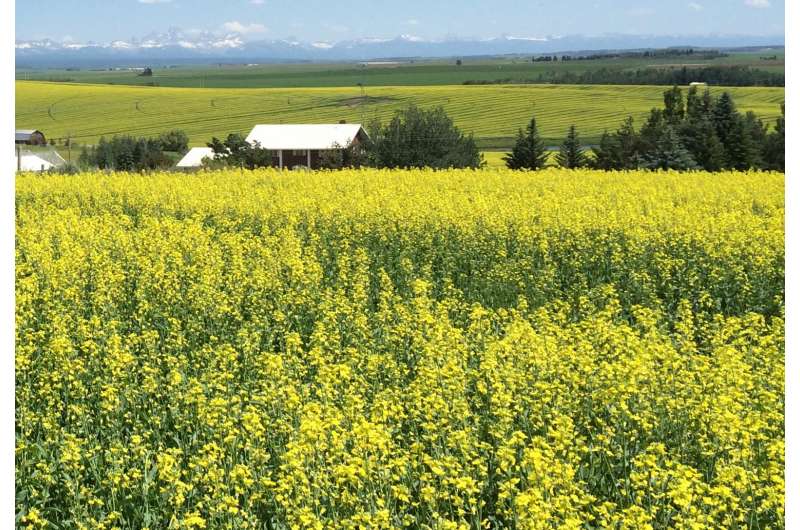Cultivating cool-for-cash-crop

When deciding what crops to grow during a season, growers look at several factors. Do the crops have a good yield in their area? Does the area currently have the resources—usually water—to grow that crop? Will the crop give a return on the investment? And, what are the future effects that growing that crop might have on the growers' fields?
That's many factors!
In California, growers usually choose warm season crops: ones that grow from March to October. But, extension agronomist Stephen Kaffka, and his team at UC Davis, including project scientist Nic George, explored growing cool season crops in the same areas. These are grown from October to June.
Why? "Warm-season crops require a lot of irrigation water," says Kaffka. "They tend to be high-value, but water demanding. Cool season crops have three advantages: the cooler temperatures allow plants to grow without losing as much water through transpiration (like humans' sweat) as crops that grow during hot weather. There is also less evaporation of moisture from the soil. Lastly, the cool season is when California, in particular, gets most of its rainfall—so cool season crops benefit from this direct source of water."
Kaffka's team looked at growing canola and camelina. Both are cool-season crops that produce oilseeds. These are seeds that are harvested and processed into oils. Canola and camelina also provide oilseed meal by-products, used for livestock feed. Both crops can be used for biofuels.
There is a market demand for cool-season oilseed crops if U.S. growers used them in their crop rotations. "Worldwide, canola and camelina have been used to diversify cereal-based agricultural systems," say the researchers. "At present, the demand for these products in the United States is considerably larger than domestic production."
Using oilseed crops instead of wheat can provide several advantages. "They can provide a disease break when problems arise in wheat and other small grains. Growing a broadleaf crop where cereals are produced can provide growers with a greater flexibility in weed control options, especially if grassy weeds have become a problem."
With all these benefits, why don't growers just make the choice to grow canola or camelina?
The choice about which crop to grow can be complicated, especially in California where many crops are possible. And growers need to have a high degree of confidence that their investment in a crop will provide a good yield, with enough profit to make the crop competitive with other crop choices they have available.
There are many new varieties of canola and camelina. Canola varieties vary with respect to length of growing season, and tolerance or need for winter chilling. Most camelina varieties are new to cultivation in the United States. Growers need recommendations from researchers about the type of variety to grow, the ideal times to plant, and other factors.
Why did Kaffka's team decide to research oilseed crops? "California's climate is similar to southern Australia, where cool-season crops are grown primarily on natural rainfall in winter," say Kaffka and George. "That region sustains an extensive and successful canola industry. It suggests the agronomic methods and varieties developed for canola in southern Australia could be adopted in California."
One factor in the success of canola for southern Australia has been the development of varieties that grow well in that area. Canola varieties developed for Australia have shorter growing season than most commercially available spring-type canola varieties grown in the rest of North America. They flower and set seed before summer drought and heat stress, which can suppress yields in longer season varieties. However, canola can become unreliable in low or more erratic rainfall conditions, according to Kaffka.
Over the course of three growing seasons, the UC Davis team planted more than 40 varieties of canola and over 60 types of camelina at multiple locations throughout the state. The varieties had a diversity of genetic backgrounds and included both commercial and experimental material. The researchers also carefully recorded variables about the fields and seasonal growing conditions, like the physical and chemical properties of the soil, the amount of rainfall that year, and how much irrigation was used.
Kaffka's research team showed canola was a clear winner for growing in California. "Canola achieved high yields and seed oil content," says Kaffka. "Using short to mid-season varieties, grown in winter, could help canola become an economically viable crop in California."
The results for camelina were not as clear. Its yield and seed oil content were lower and more variable than canola. However, it "displayed greater cold and drought tolerance, so the possibility of camelina being viable for particular niches in California should be investigated further," says Kaffka.
Kaffka's team also recommends that further research evaluate more varieties of both crops. Looking at more short-season spring varieties could find even better varieties to recommend to growers. "Agronomic questions that still need research include crop water use, and appropriate irrigation management. We also need research on the effect of diverse planting dates on yield, especially as it relates to soil moisture and temperature."
More information: Nicholas George et al, Canola and Camelina as New Crop Options for Cool-Season Production in California, Crop Science (2017). DOI: 10.2135/cropsci2016.04.0208
Provided by American Society of Agronomy
















